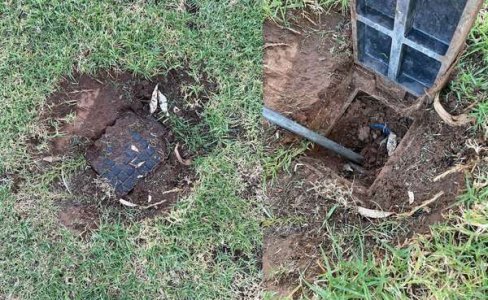Firefighters warn residents over hidden fire hydrants: ‘They don’t understand’
By
Seia Ibanez
- Replies 13
Fire hydrants are a crucial part of our emergency services infrastructure.
They provide firefighters with a vital water source to combat blazes, and in a country like Australia, where bushfires are a perennial threat, their importance cannot be overstated.
Firefighters warn Australians about a potentially fatal mistake many homeowners are making, and it's right in their front yards.
Superintendent Adam Dewberry with New South Wales (NSW) Fire and Rescue has raised a red flag about a common issue hampering their effectiveness.
Fire hydrants are often obscured by grass, weeds, and dirt, making them difficult to locate in an emergency.

In NSW, fire hydrants are typically situated a few feet underground, often under footpaths, roads, nature strips, or in front of residential properties.
They are marked by a surface fitting that should be easily visible. However, the reality is that these markers are frequently hidden from view.
Photos shared by NSW Fire and Rescue illustrated the problem. It showed a fire hydrant in Finley, a town in the Murray region of NSW, had been buried under grass and dirt.
Firefighters had to dig it up during a routine check, even though it's not their responsibility to maintain these hydrants.
'The occupants, the homeowners need to just keep them clear because it's not only protecting their homes, but it's also protecting their neighbours, homes, and also commercial premises as well,' Dewberry explained.
‘Even though we carry 2000 litres of water on the truck, we still need water from the mains to put out a fire—and the bigger the fire, the more water we need.’
Fire trucks carry a substantial amount of water, but for larger fires, they need to tap into the mains.
Fire and Rescue NSW said that hydrants are typically positioned 50-100 metres apart in residential areas, depending on the lay of the land and the presence of other services like phone lines, power, and gas.
While hydrants on the road are usually visible, ‘but when they're in front of homes people don't know what they are and they're usually left unattended’.
'People just don't understand how important they are,' Dewberry added.
Firefighters use markers on telegraph poles or fences and ‘data terminals’ to locate hydrants.
However, in the heat of an emergency, especially in the middle of the night, finding a hidden hydrant can be a time-consuming task.
'Even in the clear light of day, it can sometimes take up to 20 minutes to find the hydrant. Meanwhile, the fire's still burning,' Dewberry said.
The fire department has urged Australians to be ‘mindful of hydrant valves when landscaping’ and to keep the area around them clear.
Some homeowners admitted they were unaware of this responsibility, while others suggested that councils should play a larger role in maintaining them.
One practical tip Dewberry shared is to paint the hydrants a bright colour to make them easily visible.
A homeowner who regularly does this said, 'It only takes a few minutes to walk out the front to keep it in good order. And when they only have a few minutes to save your house and family, every minute [counts].'
This warning comes as bushfires continue to ravage parts of rural Victoria, forcing thousands of residents to evacuate.
Several areas of Western Australia were also affected by bushfires in January, where the Department of Fire and Emergency Services WA stated that ‘there is a threat to lives and homes’.
 What are your thoughts on this issue, members? Were you aware of the importance of maintaining clear access to fire hydrants? Let us know in the comments below.
What are your thoughts on this issue, members? Were you aware of the importance of maintaining clear access to fire hydrants? Let us know in the comments below.
They provide firefighters with a vital water source to combat blazes, and in a country like Australia, where bushfires are a perennial threat, their importance cannot be overstated.
Firefighters warn Australians about a potentially fatal mistake many homeowners are making, and it's right in their front yards.
Superintendent Adam Dewberry with New South Wales (NSW) Fire and Rescue has raised a red flag about a common issue hampering their effectiveness.
Fire hydrants are often obscured by grass, weeds, and dirt, making them difficult to locate in an emergency.

NSW Fire and Rescue showed the fire hydrant problem in the area. Credit: Fire and Rescue NSW Station 293 Finley / Facebook
In NSW, fire hydrants are typically situated a few feet underground, often under footpaths, roads, nature strips, or in front of residential properties.
They are marked by a surface fitting that should be easily visible. However, the reality is that these markers are frequently hidden from view.
Photos shared by NSW Fire and Rescue illustrated the problem. It showed a fire hydrant in Finley, a town in the Murray region of NSW, had been buried under grass and dirt.
Firefighters had to dig it up during a routine check, even though it's not their responsibility to maintain these hydrants.
'The occupants, the homeowners need to just keep them clear because it's not only protecting their homes, but it's also protecting their neighbours, homes, and also commercial premises as well,' Dewberry explained.
‘Even though we carry 2000 litres of water on the truck, we still need water from the mains to put out a fire—and the bigger the fire, the more water we need.’
Fire trucks carry a substantial amount of water, but for larger fires, they need to tap into the mains.
Fire and Rescue NSW said that hydrants are typically positioned 50-100 metres apart in residential areas, depending on the lay of the land and the presence of other services like phone lines, power, and gas.
While hydrants on the road are usually visible, ‘but when they're in front of homes people don't know what they are and they're usually left unattended’.
'People just don't understand how important they are,' Dewberry added.
Firefighters use markers on telegraph poles or fences and ‘data terminals’ to locate hydrants.
However, in the heat of an emergency, especially in the middle of the night, finding a hidden hydrant can be a time-consuming task.
'Even in the clear light of day, it can sometimes take up to 20 minutes to find the hydrant. Meanwhile, the fire's still burning,' Dewberry said.
The fire department has urged Australians to be ‘mindful of hydrant valves when landscaping’ and to keep the area around them clear.
Some homeowners admitted they were unaware of this responsibility, while others suggested that councils should play a larger role in maintaining them.
One practical tip Dewberry shared is to paint the hydrants a bright colour to make them easily visible.
A homeowner who regularly does this said, 'It only takes a few minutes to walk out the front to keep it in good order. And when they only have a few minutes to save your house and family, every minute [counts].'
This warning comes as bushfires continue to ravage parts of rural Victoria, forcing thousands of residents to evacuate.
Several areas of Western Australia were also affected by bushfires in January, where the Department of Fire and Emergency Services WA stated that ‘there is a threat to lives and homes’.
Key Takeaways
- Fire hydrants in Australian streets, particularly in NSW, are often obscured by grass, weeds, and dirt, posing a risk during firefighting efforts.
- NSW Fire and Rescue emphasises the importance of homeowners keeping hydrants clear to protect their own and their neighbours' properties.
- Residents are advised to be aware of the hydrants' locations and ensure they are visible and accessible, which can be critical in an emergency.
- The warning about maintaining visibility of fire hydrants comes as bushfires in rural Victoria prompt evacuations, underscoring the urgency of quick access to water sources during fires.







